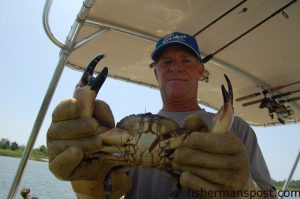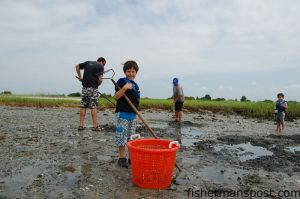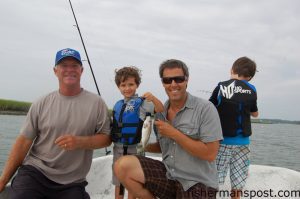The Waterman’s Way

Capt. Jeff Wolfe, of Seahawk Inshore Fishing Charters, with a stone crab that was promptly released (with both claws intact).
“That’s the biggest net I’ve ever seen!” five-year-old Owen Hurley excitedly exclaimed as a custom 120 yard seine net paid its way off the bow of Capt. Jeff Wolfe’s Carolina Skiff. “How do you throw it?”
“It’s not a cast net, Owen,” father and Fisherman’s Post Publisher Gary Hurley explained. “You don’t throw it.”
“It’s the coolest net I’ve ever seen,” Owen shot back. “I want one!”
Having only experienced 4-6’ cast nets in the past, the boy’s question was totally reasonable, as the net was pretty impressive even to Gary and I. This day the four of us had joined Jeff for a special trip, and the kids were learning something new—The Waterman’s Way.
Jeff, who fished the Cape Fear waters commercially for over 25 years before starting his Seahawk Inshore Charters business five years ago, offers his Waterman’s Way Seafood charters as a way for families to spend time on the water together, learn a variety of commercial and recreational fishing techniques, and take home a variety of fresh seafood.
With James and Owen’s mother, Leslie, out of town last weekend, I’m certain Gary was looking for a new diversion for the boys, and Jeff’s specialized trip represented an ideal way to pass a Sunday morning.
I tagged along for the experience, meeting the three Hurley boys at the Trails End boat ramp early that morning. James and Owen’s overflowing energy contrasted a mild sleep-grog I’d yet to shake, but their liveliness was infectious.
Jeff’s son Christian, an accomplished angler himself, was returning to the ramp from a successful morning topwater red drum trip in Jeff’s 17’ Ranger Banshee as the captain arrived with the Waterman’s Way platform, a wide 19’ Carolina Skiff with a canopy top large enough to shade all aboard with ease.
We climbed aboard the skiff as Christian loaded the Banshee, situating ourselves amidst an array of varied fishing gear—the massive seine net folded up a in a tarp, a quintet of clam rakes, coolers, fish baskets, light spinning rods, and more—hints of what was to come.
“Capt. Jeff’s in charge now,” Gary reminded the kids as we putted from the ramp into Whiskey Creek. “You boys have to listen to him.”
“There are rules aboard this boat,” Jeff added with his best Barney Fife inflection. “Rule number one—Obey all rules!”
Our first stop of the morning was a quick one for the adults (term used loosely) aboard. “Gary and Max, let’s try and get you guys a red real quick off this dock,” Jeff said, nosing the skiff behind a nearby pier extending into the ICW. We dunked mud minnows beneath the structure for a moment, enlisting the boys to hand us fresh minnows as some voracious croakers and undersized sea bass quickly had their way with the little baits.
“I caught a minnow, here Max,” James said excitedly, before his older brother was quick to trump him.
“I caught four minnows!” Owen sang back.
Minnow-nabbing quickly wore tired for the pair, however, and the boys were ready to get on the move before we had a chance to truly prospect the structure for a drum.
“Capt. Jeff, we like going fast!” they reiterated several times.
Next on the agenda was some fast-action rod-and-reeling for the kids, so Jeff piloted the skiff to a small channel adjacent to Masonboro Inlet, cranking up the motor to the delighted squeals of the Hurley boys.
Breaking out a pair of light spinning outfits with double bottom rigs on them, Jeff handed one to each youth. A few casting lessons and lost shrimp chunks later, they were steadily reeling in pinfish and croakers, enjoying the fraternal competition.
James jumped to an early lead, with a bent rod on nearly every cast, but after a tutorial about keeping the line tight, Owen began narrowing the margin.
The older youth finished up with a double-header, decking a pinfish and a croaker on one cast. Satisfied that he’d topped his younger brother despite the fact James had put more fish in Jeff’s crab bait bucket, he hung up his rod while Jeff gauged the water level on the nearby marsh bank.
“You boys want to get out on a sandbar?” he queried, apparently satisfied with the tide level.
The answer was a definitive yes, and we made a quick jaunt a bit closer to the inlet.
“Want to find some sand dollars to give to your Mom?” the captain asked as he dropped an anchor a few yards off the shoreline. Hopping out of the boat, Jeff began shuffling backwards in the knee-deep water, bending over to pluck a sand dollar from the bottom before he’d gone 10’.
The boys seemed unsure at first, but were soon thrilled to ferry sand dollars that Jeff pulled from the bottom back to the skiff.
“Your mom’s going to give you a dollar for each one,” I informed them as the discs piled up atop one of Jeff’s coolers, “so don’t lose any.”
Jeff’s sand dollar hole was indeed lucrative, and it only took a few minutes to collect a dozen of the unusual benthic discs. Of course, a few minutes may as well be an eon in the attention span of a pre-schooler, and the boys were satisfied with the haul and ready to move on. Jeff paces these trips according to the family aboard, so he was happy to move from dollars to clams.
The sand dollar spot happens to only be a few yards from a clam bed Jeff favors, so we leaned in the skiff, grabbed clam rakes and a fish basket, and waded to a muddy, shelly area left exposed by the nearly low tide.
“I like spots like this close to the inlets that have some mud and oyster beds,” he explained, dropping the basket and burying the tines of his clam rake in the mud.
Seconds later, he tossed the first clam into the basket, soon following it up with a half dozen more before he even took a step.

Owen Hurley mugs for the camera beside a fish basket soon to be full of clams while his brother looks on and Capt. Jeff Wolfe and the author rake away in a muddy bed near a local inlet.
“I’m in a knot!” he shouted. “That’s what the old-timers used to call a bunch of clams grouped up.”
“These little ones we call nuggets,” Jeff continued, holding up a smaller clam, still well over the 1” thick legal limit. “They used to pay a little more for these, and they taste a lot better.”
Jeff’s touch with the clams was incredible, tossing at least six in the basket for each one I added, despite my studious observation and imitation. Somehow he also seemed more talented at finding the little “nuggets” instead of the larger (and tougher) chowder clams I was coming up with.
Owen and James tried a few scratches with the rakes, but seemed to enjoy collecting all the errant clams Jeff, Gary, and I threw at the fish basket that splashed down in the mud more than the clamming itself.
I raked away, adding clams to the basket steadily, if slowly, listening as Jeff’s excited shouts came over Owen and James’s chatter.
“Nugget!”
“Nugget!”
“Knot!”
“Knot of nuggets!”
At this pace, it didn’t take long until the fish basket was nearly full, and the boys’ attention span tank nearly empty.
“You guys want anymore clams?” Jeff queried Gary and me, to a negative response. “Good, the tide’s low enough to go pull the seine now.”
Heading back toward Whiskey Creek after we rinsed the clams and piled back in the skiff, Jeff hung a left, running through a channel that entered Masonboro Sound. I’ve used seine nets before, but none like Jeff’s, a custom job that is paid out from the bow of the boat like a gillnet.
After explaining a bit about the process, Jeff anchored one end of the net to the corner of an exposed sandbar, then backed the Carolina Skiff down the adjacent creek, laying the net out on a slight diagonal to the bar.
“You guys just watch that thing,” he said to Gary and I while keeping an eye behind the boat on his course. “Don’t let the leadline and the floatline get twisted. If they come off together, just shake the floatline.”
We minded the net, jiggling the float line a few times while the boys watched wide-eyed, obviously fascinated by the massive mesh wall. As the net paid nearly all the way out, Jeff had Gary and the kids grab the trailing end and hop in the water.
“Alright guys, just haul that end back toward the bar,” he said, getting the skiff out of the way.
The boys were glad to oblige, helping their dad tug the heavy net towards the sand.
Almost immediately as the net began moving, large mullet became missiles, flying panicked over the tightening float line.
I’d stepped back to snap some pictures of the hauling Hurleys, but hopped in to take a turn pulling. The net had serious mass, and with Owen and James now preoccupied with splashing in the water on the other side of the bar, it took all 260 lbs. of me leaning at a substantial angle to the sand to get the net moving.
Jeff gave an assist on the final portion of the haul, and we were soon investigating the seine’s contents on the sand. Popeye mullet and croakers were the main constituents of the catch, with plenty of blue crabs, pinfish, and a few pigfish rounding out the balance.
In the final pocket of the net lay the most unusual creatures, a pair of lookdowns—mirror shiny and incredibly compressed fish more common in tropical waters.
Owen and James had a brief moment of allure with the lookdowns and the rest of the catch, but I was thrilled, as the strange fish were soon to find new homes in my saltwater aquarium. The boys soon returned to seeing how deep they could wade before their life jackets’ floatation took over, while Jeff stowed the net.
Crabbing was the final activity on the Waterman’s Way agenda for the day, and Jeff had a string of pots set conveniently near where we’d just completed hauling the seine.
Owen responded very much in the affirmative to Jeff’s request for a mate, and he was tasked with hooking the buoy ropes with a blunt 4’ gaff.
“We can’t have a greenhorn on the boat,” the waterman said, grinning and breaking into the refrain of Bon Jovi’s “Wanted Dead or Alive.” “You miss that buoy, a helicopter’s going to come by and take you off to land.”
The youngster took the warning to heart, nabbing the first buoy without a hitch.
The first traps in the 10-pot string that Owen and Jeff hauled were practically overflowing with blue crabs, nearly all of them large enough to shake out into another fish basket and meet destiny with a steamer later that evening.
As we approached a trio of pots set along a sharply dropping shoreline, Jeff explained that he expected slightly different results.
“There’s a shelly drop-off here,” he revealed as Owen hooked the trap buoy. “This bank is usually loaded with stone crabs. We can’t take any claws today because they’re in a closed season to breed, but I wanted to show them to you guys.”

James Hurley adds another croaker to his "most fish" title, while Owen works a slow retrieve trying for another "double hookup." The Hurley boys were on a Waterman's Way trip with their Dad and Capt. Jeff Wolfe (left) of Seahawk Inshore Charters.
The other pots had had a few smaller stone crabs mixed in with the blues, but all three of these were loaded, the crabs’ bulky bodies and huge claws filling the upper levels of each trap. It was a little melancholy to free the creatures without taking a delicious claw off each one (some larger than an average lobster claw), but the reason for the closed season was apparent. At least half of the stone crabs were females bearing eggs, so we sent them on their way to further the population for the nine months a year the claws are open to harvest. One of the traps also featured another prize for my aquarium, a juvenile spadefish that somehow managed to avoid the hungry crabs.
After pulling a few more traps on another shoreline that nearly filled the bushel basket, we had more than enough crabs and clams to feed family and friends, and Owen and James were about ready to head home and be reunited with Mom.
We headed back to the ramp, divvied the day’s catch, and headed back to the real world.
Jeff’s Waterman’s Way Seafood Charters can target a variety of other fish and shellfish using other methods, and they are a surefire bet for families looking to have a good time, learn a great deal about the marine environment and the Waterman’s Way of life, and, of course, bring home a lot of delicious seafood.
He also runs traditional guided inshore trips for red drum, flounder, sheepshead, and speckled trout with live bait and artificial lures. To schedule your own adventure with Seahawk Inshore Charters, call Capt. Jeff Wolfe at (910) 619-8580 or check out www.seahawkinshorefishingcharters.com.





